| | How much soil does conservation tillage save? | How summerfallow influences erosion and infiltration | How does erosion vary by season? | Canola residue reduces erosion | Vulnerability of Alberta soils to erosion | Improvements in infiltration and erosion from good grazing management | Restoring eroded soils | Associated publications
How Much Soil does Conservation Tillage Save?
Conservation tillage is becoming more widespread in an effort to reduce soil degradation and reduce tillage costs. However, the actual decrease in soil loss that results from reduced and zero tillage in Alberta is largely unknown. We used rainfall simulator to measure runoff and soil loss from conventional (CT), reduced till (RT) and zero till (ZT or, direct seeded) field plots in the Peace River region. We approximated a one in two year storm with the simulator on five year old ZT, CT, and RT at Dawson Creek (clay loam Solonetzic Gray Luvisol) and a one in ten year storm on three year old CT and ZT at Rycroft (silty clay Dark Gray Luvisol).
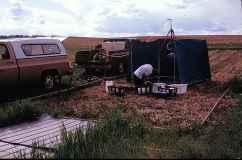
Simulator set up for the tillage study
Results
Soil loss decreased from CT (to RT at Dawson Creek) to ZT at both sites. Compared with CT, RT reduced soil loss by 30% and ZT reduced soil loss by 72% at Dawson Creek. Runoff was also greatest from CT (to RT at Dawson Creek) to ZT at both sites. Reduced soil loss and runoff from all three treatments were statistically related to increased amounts of residue cover and increased surface roughness.
Further details of this study are available in:
Nolan, S.C., van Vliet, L.J.P., Goddard ,T.W. and Flesch, T.K. 1997. Estimating storm erosion with a rainfall simulator. Canadian Journal of Soil Science. November issue.
Nolan, S.C, Goddard, T.W. and van Vliet, L.J.P. 1992. Soil erosion from selected conservation and conventional management practices. In: Proceedings of the 29th Alberta Soil Science Workshop. Feb. 18-20, Lethbridge.
Van Vliet, L.J.P., Kline, R. and Hall, J.W. 1993. Effects of three tillage treatments on seasonal runoff and soil loss in the Peace River region. Can. J. Soil Sci. 73:469-480.
How Summerfallow Influences Erosion and Infiltration
Although conservation fallow techniques are used in Alberta, it is not well known whether they actually reduce soil loss and runoff, giving the added benefit of increasing infiltration. We initiated a field study to measure runoff and soil loss from conventional and conservation methods of summerfallow using a rainfall simulator. We approximated a one in two year storm with the simulator on two farm study sites near Mundare (Black loamy sand soil) and a one in ten year storm near Skiff (Brown loam soil). Conventional fallow and chemfallow were compared at Mundare while Skiff also had a comparison of wide-bladed fallow.
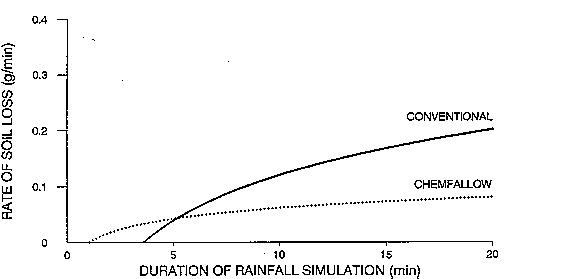
Soil loss from 1m2 plots of two types of fallow during one in two year storm on a Black loamy sand.
Results
Chemfallow was very effective in reducing soil loss. Compared with soil loss from the conventional summerfallow, total losses were reduced 77% by chemfallow on the Black loamy sand and by 86% on the Brown loam. The wide-bladed cultivator on the Brown loam also reduced soil loss from conventional summerfallow by 72%.
Infiltration into conservation fallow was significantly greater than into the conventional at both sites. Infiltration rates into the chemfallow and bladed were very similar on the Brown loam and both allowed about 36% more infiltration than did the conventional On the Black loamy sand, infiltration into the chemfallow increased by 76% relative to the conventional.
Further details of this study are available in:
Nolan, S.C, Goddard T.W. and. van Vliet, L.J.P. 1992. Soil erosion from selected conservation and conventional management practices. In: Proceedings of the 29th Alberta Soil Science Workshop. Feb. 18-20, Lethbridge.
How does Erosion Vary by Season?
The effects of long periods of partially thawed soils on springtime soil loss are not well known in Alberta. Rainfall simulation studies in 1991 and 1992 showed how soil erosion can vary over a growing season in Alberta. We used the rainfall simulator to measure runoff and soil loss from one in two year storms on summerfallow site in spring conditions (partial through fully thawed). We also measured erosion over the summer from approximately one in ten year storms. The study site was located near North Cooking Lake on an Orthic Dark Gray Luvisol loam textured soil.

Simulator study spring conditions
Results
Using the simulator to approximate a one in two year storm, we found that a field was significantly more vulnerable to erosion when it had partially thawed layers than when it was fully thawed in spring conditions. We found this for two consecutive years. On average, we measured 94% more erosion (both runoff and soil loss) from the 5 cm thaw than from the fully thawed soil. The 20 cm thaw lost 23% more soil and runoff than the fully thawed soil.
We also measured soil loss in May, July and September after simulating a one in ten year storm. Soil loss and runoff in summer conditions were very variable. After starting from similar amounts in May for both years, erosion decreased, then increased over the summer period in 1991. In 1992, erosion increased then decreased. Sediment concentrations in 1991 were roughly half of those in 1992. Surface roughness appeared to be related to amounts of erosion measured. Changes in management changed surface roughness over the course of the summer; the rougher the surface the less runoff and soil loss.
A proportionally greater amount of soil loss occurred in spring conditions of partial thaw than in summer conditions. Soil thaw depth significantly affected soil erosion in spring while in the summer, surface roughness was more influential. Although moisture conditions cannot be controlled in spring conditions when a soil is most vulnerable to erosion, protection of the soil may be addressed by increasing roughness and by residue management.
Further details of this study can be found in:
Nolan, S.C. and Goddard, T.W. . 1992. Soil erosion in field conditions of partial and completethaw using a rainfall simulator. pp. 63-64 in: Proc. 2nd Int'l Symposium on Agricultural Techniques in Cold Regions. Aug. 4-7, Edmonton, Alberta.
Nolan, S.C. and Goddard, T.W.. 1992. Variations in seasonal erosion measured with a rainfall simulator. in: Proc. Erosion: Causes to Cures conference. November 2-4, Regina, Saskatchewan. 17 pp.
Canola Residue Reduces Erosion
Crop residue reduces erosion by protecting the soil surface from the impact of raindrops. Residue also acts to slow runoff, enabling infiltration. However, its not clear whether canola residue is as effective as other types of residue in reducing erosion and increasing infiltration. We used a rainfall simulator to measure differences in soil loss and infiltration under canola and wheat crop residue. The study was conducted with similar residue cover amounts in spring conditions on a Solonetzic Dark Brown sandy loam soil. We also measured the effects of different levels of residue cover in the fall on an Orthic Brown loam soil.
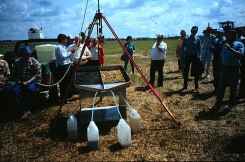
Effect of residue cover on soil loss by rainfall. Jugs in front (right) show reduced erosion from residue covered soil. Jugs in rear (right) show increased infiltration under residue cover.
Results
We found that there was no significant difference in the effects of similar amounts of wheat and canola residue on springtime soil loss after a one in two year storm. Compared with a fallow treatment, 80% canola residue reduced soil loss by one half and 80% wheat residue cover reduced soil loss by slightly more. The fallow had 14% residue cover due mainly to weeds and we expect an even greater relative reduction in soil loss due to residue cover when no weeds are present.
From our residue levels study of soil loss after a one in ten year storm, we found that increases in cover at lower levels were more effective in reducing total soil loss than increases at higher levels. For example, an increase from 9% to 22% cover reduced soil loss more than 3 times but a 20% increase from 22% to 42% only reduced soil loss by half. As residue levels increased beyond 30% cover, their added effect in reducing erosion lessened. Crop residue levels can easily be increased by shallower or less frequent tillage.
A more detailed summary of this study is available in:
Nolan, S.C., and Goddard, T.W. 1991. Rainfall Simulator Studies of Soil Erosion in Alberta. Progress report to Conservation and Development Branch, Alberta Agriculture, Food and Rural Development. Edmonton.
Vulnerability of Alberta Soils to Erosion
Its not known whether Alberta soils erode similarly to others that have been studied in the United States. Widely used US models of soil erosion are based on studies of soils with average organic matter contents ranging from 0.9 to 5.5%, whereas Alberta soils have organic matter contents as high as 12%. This information is needed to use soil erosion models that were developed in US conditions. We used our rainfall simulator to measure differences in soil loss from soils with varying textures and organic matter contents under similar management conditions. We used the simulator to approximate one in two year storms and extreme storms.
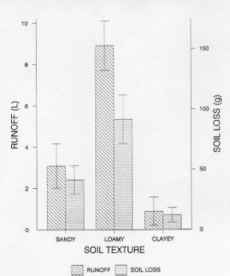
Soil loss from three soil textures within one field under similar management. Bars represent standard error.
Results
We found that soils with 3% organic matter eroded as much 100 times than those with 11% organic matter during extreme storms. These results suggest that caution should be used in the interpretation of the results of US based soil erosion models for Alberta soils with high organic matter contents.
We also found that after a one in two year storm, soils with higher silt contents and decreased levels of clay were more vulnerable to erosion than sandy soils. The loamy soil that we measured was 50% more erodible than the sandy soil and 87% more erodible than the clayey soil. An abstract of these results is available from Canadian Journal of Soil Science 77(4):669-676.
A copy of a poster describing these results is available in:
Nolan, S.C., and Goddard, T.W. 1993. Soil properties affecting erodibility in rainfall simulator field studies. pp.32-36 In: Soil Erodibilty Study by Rainfall Simulation. Progress report to Conservation and Development Branch, Alberta Agriculture. Edmonton.
Improvements in Infiltration and Erosion from Good Grazing Management
Heavily grazed rangeland can result in reduced water infiltration and increased risk of soil erosion. We approximated a one in ten year storm with the rainfall simulator on on a lease under continuous grazing and on an adjacent ungrazed area along the Peace River. We measured infiltration, soil loss, plant species composition and range production.
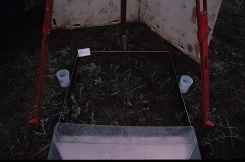 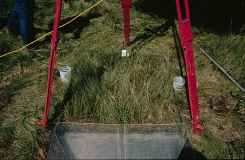
Heavily grazed and ungrazed rangeland along the Peace River.
Results
Compared with the ungrazed rangeland, intensive grazing reduced infiltration. Infiltration was 59% greater into the ungrazed than into the heavily grazed rangeland. Soil loss was also greater from the heavily grazed rangeland. The heavy grazing resulted in 38% less green biomass, 95% less litter cover and 30% less useable biomass than the ungrazed rangeland. The higher infiltration rates into the ungrazed site suggests that more moisture is available to support plant growth and maintain a healthy, viable range.
Staff from Public Lands were collaborators on this study. Further details are available in:
Breault, A., Roberton, A., Brierly, D., Skarberg, K., and Goddard, T.W. 1994. Effects of Grazing on Infiltration Rates and Soil
Loss on a Peace River Native Grassland. pp. 27- 42 In: Soil Erosion and Infiltration Measurements in Alberta. Nolan, S.C., Skarberg, K., and Goddard, T.W. Conservation and Development Branch, Alberta Agriculture, Food and Rural Development. Edmonton.
Restoring Eroded Soils
What impact does the loss of 10 or 20 cm of topsoil have on a soil's infiltration potential? Is the application of manure an effective method of restoring a soil to its original productivity and state? These are questions that we addressed using mechanically eroded or "scalped" plots near Ministik. We used our rainfall simulator to simulate extreme storms during which we measured infiltration into scalped soils that were either unamended or amended with manure.
Eroded soils shed much more water than uneroded soils. Where artificial erosion had removed 20 cm of topsoil, infiltration into the unscalped or "control" plot was reduced by almost 3 times (87%). When the soil was restored with a manure amendment, infiltration increased beyond even that of the control plot, to one and a half of the original amount. Infiltration into the amended 20 cm scalped plot increased by five times to an amount which was equal to the improved infiltration into the amended unscalped. The manure also dramatically improved crop productivity. Manure improved the yield of the unscalped plot to almost one and a half times the yield of the control. It also improved yield on the plot scalped to 20 cm by 85%.
The loss of any amount of topsoil can have a negative effect on infiltration and productivity. Manure reduces surface sealing allowing increased infiltration. Although manure is an effective way of restoring and even improving an eroded soil, it is more beneficial and less costly to retain the original topsoil.
Further details of this study are available in:
Grant, R.F., Nolan, S.C. , Gray, N., Goddard, T.W. and Izaurralde, R.C 1993. Runoff and infiltration following topsoil removal: simulation and experimental results. In: Proc. 30th Alberta Soil Science Workshop. February 23-24, Edmonton, Alberta.
Nolan, S.C. and Goddard, T.W. 1993. Comparison of infiltration using a rainfall simulator and a cyclinder infiltrometer on artificially eroded and amended soils. pp. 44-56. In: Soil Erodibility Study by Rainfall Simulation. Progress Report to the Conservation and Development Branch. Alberta Agriculture, Edmonton.
Associated Publications
Breault, A., Roberton, A., Brierly, D., Skarberg, K., and Goddard, T.W. 1994. Effects of Grazing on Infiltration Rates and Soil Loss on a Peace River Native Grassland. pp. 27- 42 In: Soil Erosion and Infiltration Measurements in Alberta. Nolan, S.C., Skarberg, K., and Goddard, T.W. Conservation and Development Branch, Alberta Agriculture, Food and Rural Development. Edmonton.
Grant, R.F., S.C. Nolan, Gray, N., Goddard, T.W.and Izaurralde, R.C.. 1993. Runoff and infiltration following topsoil removal: simulation and experimental results. In: Proc. 30th Alberta Soil Science Workshop. February 23-24, Edmonton, Alberta.
Nolan, S.C., van Vliet, L.J.P, Goddard, T.W. and Flesch, T.K.. 1997. Estimating soil loss from rainstorms. Canadian Journal of Soil Science 77(4):669-676.
Nolan, S.C., Skarberg, K. and Goddard, T.W. 1994. Soil Erosion and Infiltration Measurements in Alberta. Alberta Agriculture, Food and Rural Development. Edmonton.
Nolan, S.C., Goddard, T.W., and Skarberg, K. 1993a. Variations in sping-time erosion measured with a rainfall simulator. Irrigation and Resource Management Applied Research Report. Edmonton, Alberta. 5 pp.
Nolan, S.C. and Goddard, T.W. 1993b. Soil erodibility study by rainfall simulation. Conservation and Development Branch. Alberta Agriculture. Edmonton, Alberta.
Nolan, S.C. and Goddard, T.W. 1992a Rainfall Simulator Studies of Soil Erosion in Alberta - 1991. Edmonton, Alberta.
Nolan, S.C. and Goddard, T.W. 1992b. Soil erosion in field conditions of partial and complete thaw using a rainfall simulator. pp. 63-64 in: Proc. 2nd Int'l Symposium on Agricultural Techniques in Cold Regions. Aug. 4-7, Edmonton, Alberta.
Nolan, S.C. and Goddard, T.W. 1992c. Variations in seasonal erosion measured with a rainfall simulator. in: Proc. Erosion: Causes to Cures conference. November 2-4, Regina, Saskatchewan. 17 pp.
Nolan, S.C., Goddard, T.W. and Skarberg, K. 1992. Soil properties affecting erodibility in rainfall simulator field studies. p. 33 in: Abstracts of Environmental Soils conference. CSSS and CLRA, Edmonton, Alberta.
Nolan, S.C., Goddard, T.W.and van Vliet, L.J.P. 1992. Soil erosion from selected conservation and conventional management practices. Proc. 29th Alberta Soil Science Workshop. Feb. 18 - 20, Lethbridge, Alberta, pp. 90 - 103.
Nolan, S.C. and Goddard, T.W. 1991. Field studies of soil erosion using a rainfall simulator. Proc. 28th Alberta Soil Science Workshop. Feb. 20-21, Lethbridge, Alberta, pp. 286 - 292.
This information is provided by Sheilah Nolan and Tom Goddard |
|